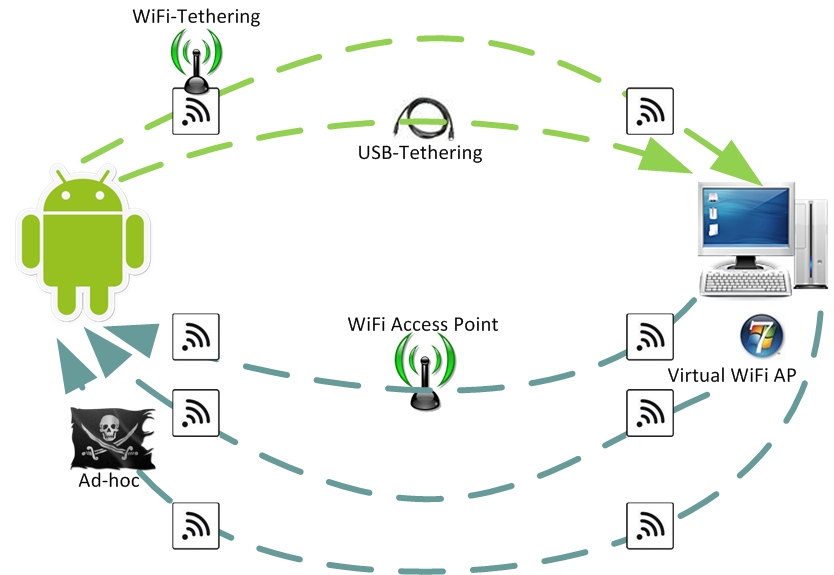Tethering and reverse tethering

This article will focus on options for transferring Internet traffic to a device running the Android platform, as well as ways to transfer Internet traffic in the opposite direction (from an Android device). These concepts are called Reverse tethering and Tethering, respectively. If things are good with the second (there are both standard and 3rd party solutions), then you need to talk about the first one and carry out a detailed analysis. But, all in order.
Immediately emphasize: outdated , irrelevant , dangerous solutions will not be considered!
All technologies are viewed only in terms of Tethering. There will be no detailed description of each of them, only the degree of applicability to the illuminated problem.

Tethering
Standard solutions
With the advent of Android 2.2, 2 technologies became possible: USB-Tethering and WiFi-Tethering.
USB tethering
To connect, you need a standard Android-USB cable.
Enabled in Settings-> Wireless Networks-> Modem Mode-> USB Modem.
After connecting the Android device to the receiver (laptop, desktop computer ...) with a cable, a request is made to enable USB-Tethering. After a positive user response, it becomes possible to use the Internet traffic of the Android device on the receiver.
A big plus of this approach is the ability to connect Android devices to a WiFi Access Point and to divide this connection via USB channel.
Of the minuses worth noting the need to keep the Android device in close proximity to the receiver and the limitations of only one receiver.
WiFi tethering
To connect, you need a WiFi adapter on the receiver.
If you previously had to use android-wifi-tether , which required Root , now, with the advent of Android 2.2, this is done using standard tools.
Enabled in Settings-> Wireless Networks-> Modem Mode-> Wi-Fi Hotspot.
After enabling this Android function, the device becomes a Wi-Fi access point to which other devices can connect.
The big disadvantage is the impossibility of simultaneously receiving and distributing Internet traffic by Android device via WiFi, i.e. Android device becomes a 3G modem for the receiver.
')
3rd party
EasyTether
To connect, you need either a standard Android-USB cable or a WiFi adapter on the receiver.
Allows you to connect your Android device to the receiver and implement Tethering.
Requires installation of the application on both the Android device and the receiver.
It does not make sense after the appearance of Android 2.2, but, at one time, a very flexible and useful tool.
Reverse tethering
We turn to the most interesting place of the article.
Because There is very little clearly structured information on this issue, I think it is very important to convey the facts about the current situation to the attention of the Internet community.
At the moment, Reverse tethering, as such, has not yet been implemented by standard means. No, also, 3rd Party products that allow Reverse tethering to be made without special configuration. But, the attentive reader has already noticed the phrase “special setting”. This is what we will do. From the banal to the more complex.
Some proposed solutions will be based on a well-known mechanism for dividing Internet traffic, which we will not discuss in this article. There are many articles describing this mechanism. What is really interesting is the connection options of the Android device and the source.
Standard solutions
WiFI Access Point
The most obvious solution.
High speed, average territorial availability, for honest people - also some cash costs.
But the access point is not always at hand. Then…
2G / 3G
To date, the coverage area is not yet stable, prices are too high, the speed is average.
Prospects are good, but not available to everyone. Well, the last hope remains.
Ad-hoc
Before us is a computer (source) connected to the Internet via a standard network cable - twisted pair. It has a WiFi adapter that we use to connect to an Android device. This connection is called Ad-hoc.
However, such a connection is currently not available for Android devices, although this possibility is incorporated into the Android platform itself.
I urge everyone to vote for correcting this flaw on the official error page . It is enough to put a star in the upper left corner. Thank.
Custom solutions
Virtual WiFI Access Point
In Windows 7, it became possible to create a virtual WiFI Access Point .
This allows you to connect your Android device to the source without using a real WiFI Access Point.
To simplify the procedure, the Connectify program was created.
The obvious disadvantage is that not everyone wants to work (there is no possibility to install) Windows 7.
Ad-hoc
It is possible to create ad-hoc connections manually. But only when using Root .
In the file /system/etc/wifi/tiwlan.ini we rule:
WiFiAdhoc = 1
dot11DesiredSSID = HTCG1Default
dot11DesiredBSSType = 0
Thus, you create one connection Ad-hoc.
You can search for details yourself, because I strictly do not recommend using this method.
Ad-hoc - flashing
There is an unofficial patch that includes the ability to find and connect to Ad-hoc networks, marking them *. Again, at your own risk .
UPD:
USB
You can customize the USB connection manually. Only when using Root .
The instruction is written clearly and easily.
Conclusion
The Android platform provides a number of opportunities to get Internet traffic to devices, but not nearly as easy as we would like. In places, as you can see, it is even dangerous. The simplest solution is to purchase a portable WiFI Access Point and wait for a solution to the Ad-hoc connection problem .
Source: https://habr.com/ru/post/103270/
All Articles